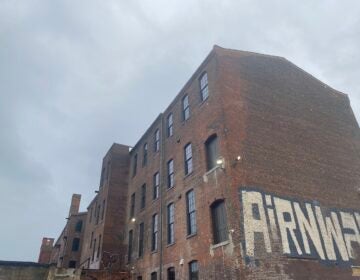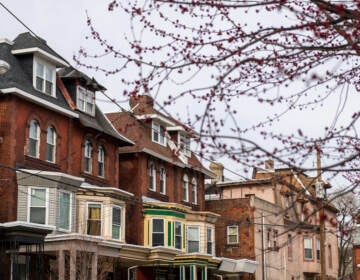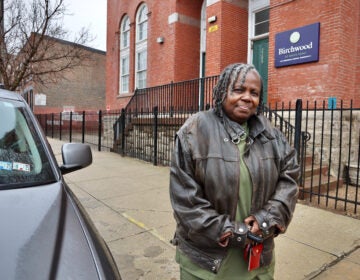Three reasons why Philadelphia won’t follow Minneapolis’s ban on single-family zoning
In December, Minneapolis City Council voted for the ban to confront a growing affordability crisis and longstanding patterns of racial segregation.

Single-family houses with ground floor garages recently rose on the 200 block of Arch Street. (Ashley Hahn/PlanPhilly)
This story originally appeared on PlanPhilly.
—
For people who follow U.S. housing policy, 2018 ended with a radical suggestion hanging in the air. In December, Minneapolis confronted a growing affordability crisis and longstanding patterns of racial segregation with a City Council vote in favor of a plan to eliminate single-family zoning.
The classification, which dominates Philadelphia, originated in a time when racist ideology permeated city planning. Exlusively single-family neighborhoods have perpetuated segregation in communities of all kinds for generations.
Single-family zoning’s probable demise in Minneapolis comes as part of a bold plan spearheaded by a new mayor and approved by a progressive majority on the city council that would allow triplexes to be built everywhere in the city; eliminate mandatory parking minimums; and further incentivize development around transportation hubs.
“Zoning is only one tool — and not enough to tackle our city’s racial disparities — but it was one way we could reverse historic patterns of exclusion,” said Lisa Bender, the Minneapolis City Council president.
Minneapolis has not yet been officially adopted the plan. If and when it does, it will represent a turning point in modern American urban planning, a break from 20th-century practices linked to increasing inequality, car dependency, and health problems.
But just how applicable is Minneapolis’ big idea to the City of Brotherly Love?
The answer to that is complex. Politically, its a non-starter. To date, no Philadelphia City Council members have publicly embraced the idea of ending single-family zoning here, and, in terms of legislative action, the Council has essentially taken the opposite tack. Instead of increased allowable density in hot neighborhoods adjacent to Center City, these areas are often being downzoned to single family. When the Planning Commission proposes upzoning commercial corridors, Council members often consent to only modest changes. Few on Council are taking advantage of the new transit-oriented development overlay, and two stations that were going to be given the designation in the booming Fishtown neighborhood were quietly removed. As for the accessory dwelling units recently (2014) greenlighted in Minneapolis, those were prevented from moving forward in Philly during the Nutter administration’s zoning overhaul.
Even so, there are still lessons Philadelphia can learn from Minneapolis.
We spoke to an array of local experts, city officials, and City Council members who emphasized three big differences between the two cities. They also explained why Philly should be paying attention to the experiment up north.
Bender, for her part, cautioned that she did not wish to comment on Philadelphia, but she offered broad advice for local policymakers who are not necessarily operating in the scorching-hot housing markets of the Bay Area or New York City.
“Cities that are in a different reality, when a neighborhood is at a point of disinvestment, that’s a really good time to think long-term,” Bender said. “There are communities that have missed that opportunity and have just become completely unaffordable to regular working people. So there is a real opportunity when there’s a pause in the market or a downturn.”
5 row houses can fit inside the typical Minneapolis lot
Philadelphia’s housing stock has a higher proportion of row houses than any other big city in America. That means there is a greater degree of density packed into even single-family neighborhoods than in a city like Minneapolis, where detached homes on distinct lots surrounded by lawns are the norm.
“Minneapolis is a midwestern city with a midwestern housing stock,” said Gary Jastrzab, retired executive director of the Philadelphia Planning Commission. “I don’t think [Minneapolis’s plan] is terribly applicable to Philadelphia. We already have the density they get from triplexes. They have about 60-foot frontages, where we have 18-foot. It comes out to the same kind of density.”
In Minneapolis’ most common single-family zoning category, the highest buildings allowed are 33 feet, with front setbacks of 20 feet, and a minimum open area of 55 percent. In Philadelphia, the most common single-family zoning district allows heights of 38 feet, zero front setback, and a 20- to 25 percent open-area requirement.
The typical lot size in Minneapolis is 5,000 square feet, while lots well under 1,000 feet are common in Philly’s inner neighborhoods.
Then there’s the question of housing availability. In Philadelphia, home prices are rising, but the median home sale price is $142,000. For renters, the vacancy rate is 8 percent, so landlords have to offer more incentives and lower rents to attract tenants. In Minneapolis, the median sale price is over $262,000, and the rental vacancy rate is 2 percent.
“I like the idea [of the zoning overhaul], but I think Minneapolis is very different from Philadelphia,” said Councilman Allan Domb, who is also one of the most prominent real estate brokers in the city. “I’m not sure we have a housing shortage here right now. Of the top 20 cities, we are either the first or second most affordable.”
For politicians who represent neighborhoods where there is little new construction, the policies pursued by Minneapolis have little relevance to the needs confronting constituents.
Councilwoman Cherelle Parker said that neighborhoods in the 9th District — which includes many working- and middle-class predominantly African-American communities of single-family row homes — don’t need rezoning, they need stabilization.
“The homes in the 9th District have good bones, and, if preserved now, they can be around for decades more to come,” Parker wrote in an email message. “For most of these homes, it wouldn’t be possible to turn them into triplexes without completely gutting them, or just knocking them down and building new, something I want to avoid.”
‘A success story when it comes to African-American homeownership’
Philadelphia is a much larger and poorer city than Minneapolis. More than 25 percent of Philadelphians live below the poverty rate, and the median income is just over $40,000, while Minneapolis has a median income over $55,000. There are almost as many people living in poverty in the City of Brotherly Love as live in all of Minneapolis.
And for all the benefits that experts say zoning reform can bring, it is not seen as an effective means to provide housing for those poor enough to require subsidy to comfortably afford housing.
“Philadelphia’s housing challenges are more frequently related to resources than to zoning,” said Paul Chrystie, a spokesman for Mayor Jim Kenney’s administration.
Philadelphia faces different challenges than cities where housing supply is one of the principal housing policy issues.
In Los Angeles, New York, San Francisco, Seattle, and, increasingly, cities like Minneapolis, middle-income residents are being priced out because the urban population and job market are growing, but the housing supply isn’t. That means even households making over $100,000 a year are struggling to find homes in the city.
In Philadelphia, some high-paying jobs have returned to the city center, but the majority of the opportunities at the high end of the job market remain scattered across the suburban counties. Outside of the hottest neighborhoods, most middle-income people in Philadelphia can find housing.
The principal housing issue facing Philadelphia is that most low-income residents live without subsidies and can barely afford their rent. No matter how many units are built, the price reductions that stem from greater supply are not large enough to help the poorest.
Racial segregation plays out differently in Philadelphia too. The reformers in Minneapolis pushed for the end of single-family zoning on the basis of its role in reinforcing long-standing patterns of segregation.
The practice of banning apartments from certain neighborhoods originated in racial animus, emerging only after the Supreme Court ruled that explicitly race-based zoning was found to be unconstitutional in 1917. The progressive politicians of Minneapolis argued that allowing triplexes everywhere would loosen the legacy of these old practices.
But even after years of decline, Philadelphia’s homeownership rate is higher than in Minneapolis and it is not so concentrated among white residents. Many local politicians are influenced by homeowner groups whose memberships are majority people of color and whose concerns cannot be dismissed as racist.
“I was struck by how, in Minneapolis, neighborhoods that are majority homeowner are also always neighborhoods with few, if any, minorities,” wrote Parker. “But that isn’t the case in all neighborhoods in Philadelphia; in fact, the 9th Council District is a success story when it comes to African-American homeownership.”
‘A big city with a small-town feel’
Philadelphia is a Democratic stronghold, yet its old school political culture hasn’t always proved amenable to dramatic policy shakeups.
Minneapolis’s radical zoning overhaul is the fruit of a sweeping turnover on its city council and a willingness to try new strategies in the face of an incipient housing crisis.
“It’s a very liberal city council politically,” said Jastrzab. “We’re not there yet. There are a few liberal members, but not like Minneapolis. I wouldn’t foresee something like that [eliminating single-family zoning] happening in Philadelphia.”
But Council President Darrell Clarke’s press representative, Jane Roh, notes that Philly policymakers are focused on different housing policies to help low-income and working-class constituents. These include the new home preservation loan program, set to debut soon, and a $53 million commitment Council secured from Kenney to be spent on down payment assistance and workforce housing.
Councilwoman Maria Quiñones-Sánchez, whose attempt to bring mandatory inclusionary zoning to Philadelphia was defeated in 2017, said that “one size does not fit all.” She highlighted alternative policies that she and other Council members have championed, such as a beefed-up voluntary inclusionary zoning bonus and additional transit-oriented development overlays. Quiñones-Sánchez also said that she wants to introduce mandatory inclusionary zoning for developers who build in the Opportunity Zones created by President Donald Trump’s tax cut.
But the dominant attitude on Council can be summed up by Councilman Mark Squilla.
“Philly is a big city with a small town feel, and the reason we still have a small town feel is that you have a lot of single-family homes and people who live in those communities for generations,” said Squilla, who represents a district where many of the city’s hottest neighborhoods are located.
Squilla said these areas should be preserved, and density should be targeted to transportation hubs and commercial corridors.
“I don’t think it’s a good idea to change everything to multifamily,” said Squilla. “We see what happens in a lot of these communities that have a lot of multifamily residents. We don’t have the same stakeholder buy-in from renters as people who own the property.”
So, what can we learn from Minneapolis?
Minneapolis and Philadelphia are very different cities. That much is clear. But housing and planning experts caution that Philadelphia policymakers should not casually dismiss the Minneapolis plan.
There are single-family neighborhoods in Philadelphia where there is a demand for smaller, cheaper housing units that are affordable to young professionals, artists, seniors, and stably employed service-sector workers.
But that isn’t what’s happening. Booming Spruce Hill recently downzoned itself to single family as a means of historic preservation, casting doubt on its tradition of apartment living in old Victorian mansions. Many other desirable neighborhoods have made similar choices, often as a means to keep out renters. Point Breeze is currently zoned to accommodate multifamily rowhouse apartments, but will probably be downzoned to single-family in the new year. That will make it far more likely that urban ‘McMansions,’ sold at Graduate Hospital prices, will rise on the neighborhood’s vacant lots.
Experts say that policymakers don’t have to necessarily export the Minneapolis plan but should instead analyze where market demand is hottest and where it is likely to move next, and zone accordingly.
“[Upzoning] is not a panacea, it’s just one of many things we need to be doing,” said Vincent Reina, assistant professor in the Department of City and Regional Planning at the University of Pennsylvania. “But it can ensure a lot of middle-income housing in neighborhoods that are becoming more costly even for middle-income households. This approach could be very useful in neighborhoods like Point Breeze and neighborhoods that are the future Point Breezes.”
The Kenney administration released a housing action plan earlier this year calling for exactly that.
The plan includes more transit-oriented development overlays around transportation hubs and recommends higher density zoning in neighborhoods with strong housing markets. It also suggests expansive use of the new inclusionary zoning bonus, which encourages developers to provide affordable housing in exchange for greater density in their buildings. It notably cannot be used in single-family zoning districts.
The Kenney administration will need the support of the Council to move forward with the proposals included in its housing plan.
Councilwoman Helen Gym, who took to Twitter to praise Minneapolis’s proposal, said that the city’s plan and the inclusionary zoning incentive represented a start in the fight against segregation but that impact would be limited because the density bonus cannot be used in in single-family areas.
“In Philadelphia, we’ve recently started taking on desegregation through the groundbreaking fair housing plan. Inclusionary zoning, which has been championed by my colleague Councilwoman María Quiñones-Sánchez, is a major step, and to the extent, we expand multifamily zoning it will have even greater reach,” she said. “But, like in Minneapolis, we will need all Philadelphians who prioritize equitable development to organize for what they believe in.”
—
 WHYY is one of 22 news organizations producing Broke in Philly, a collaborative reporting project on solutions to poverty and the city’s push toward economic justice. See all of our reporting at brokeinphilly.org.
WHYY is one of 22 news organizations producing Broke in Philly, a collaborative reporting project on solutions to poverty and the city’s push toward economic justice. See all of our reporting at brokeinphilly.org.
WHYY is your source for fact-based, in-depth journalism and information. As a nonprofit organization, we rely on financial support from readers like you. Please give today.







